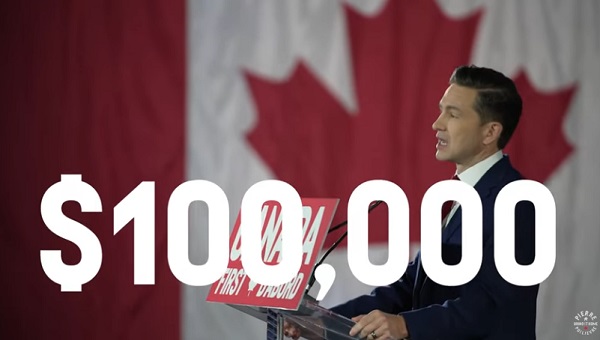Daily Caller
Trump Could Upend Every Facet Of The Obama-Biden Climate Agenda In One Fell Swoop


From the Daily Caller News Foundation
By
Every week in this second Donald Trump presidency is such a whirlwind of major events that it is always a challenge to pick a topic for the next contribution here at the Daily Caller News Foundation.
But, despite this having been one of the most frenzied weeks of all since Jan. 20, picking the topic for this column was easy, because no energy-related action by this administration would have a bigger impact on American society than a successful effort to reverse the Obama EPA’s 2009 endangerment finding on greenhouse gas regulation.
The Washington Post reported Wednesday that Environmental Protection Agency (EPA) Administrator Lee Zeldin “has privately urged the White House to strike down a scientific finding underpinning much of the federal government’s push to combat climate change, according to three people briefed on the matter who spoke on the condition of anonymity because they were not authorized to comment publicly.” Zeldin’s recommendation was a response to Trump’s Day 1 executive order tasking Zeldin to conduct a review of “the legality and continuing applicability of the Administrator’s findings, ‘Endangerment and Cause or Contribute Findings for Greenhouse Gases Under Section 202(a) of the Clean Air Act,” Final Rule, 74 FR 66496 (December 15, 2009).’”
Dear Readers:
As a nonprofit, we are dependent on the generosity of our readers.
Please consider making a small donation of any amount here.
Thank you!
The Obama EPA’s finding was enabled by the 2007 5-4 ruling by the Supreme Court in the Massachusetts v. EPA case allowing the agency to regulate greenhouse gases as pollutants in the context of the Clean Air Act. In that case, Justice Anthony Kennedy, who long served as the swing vote on the Court, joined with four liberal justices to give EPA this authority.
Given that the main so-called “greenhouse gases” — water vapor, methane and carbon dioxide — are all naturally occurring elements, a ruling classifying them as “pollutants” as that term was intended by the authors of the Clean Air Act in 1963 was absurd on its face, but that didn’t stop the five justices from imposing their political will on U.S. society.
Since implemented by the Obama EPA, the endangerment finding has served as the foundational basis for the vast expansion of climate change regulations impacting every nook and cranny of the U.S. economy, dramatically increasing the cost of energy for all Americans. The climate alarm hysteria over carbon dioxide, otherwise known as plant food and the basis for all life in Planet Earth, was also the motivational basis for every aspect of the Biden-era efforts to force taxpayers to bear the cost of hundreds of billions of dollars in renewable energy subsidies.
So, what has changed between 2007 and today to make Administrator Zeldin and President Trump think their attempt to reverse this endangerment finding would survive all the court challenges that would arise from the climate alarm community?
First, there is the dramatic shift in the makeup of the Supreme Court. Justice Kennedy is no longer on the court, nor are the other four justices who issued the majority decision in Massachusetts v. EPA. Where the Court was evenly divided in 2007, today’s Supreme Court is made up of a decisive 6-3 originalist majority with three justices appointed by Donald Trump himself during his first presidency.
But an even more decisive difference now stems from last year’s reversal of the Chevron Deference by the Supreme Court in the Loper Bright Enterprises v. Raimondo case. As I wrote here at the time, the Chevron Deference, established as a legal doctrine in a unanimous Supreme Court decision in 1984, required the federal judiciary to defer to the regulators’ judgments about the governing statutes whenever the statutory intent was vague and open to interpretation.
That doctrine of law led directly to the vast expansion of the regulatory state for the 40 years it was in effect. The question now becomes whether, in the absence of that doctrine, regulators at the EPA truly have the authority to regulate atmospheric plant food in the same way they regulate particulate matter and other forms of real air pollution.
A successful effort to reverse the Obama EPA endangerment finding would then put every element of the Obama/Biden climate agenda in jeopardy.
Mr. Trump likes to say he wants to bring common sense back to government. This is one big way to do exactly that.
David Blackmon is an energy writer and consultant based in Texas. He spent 40 years in the oil and gas business, where he specialized in public policy and communications.
Daily Caller
AI Needs Natural Gas To Survive


From the Daily Caller News Foundation
By David Blackmon
As recent studies project a big rise in power generation demand from the big datacenters that are proliferating around the United States, the big question continues to focus in on what forms of generation will rise to meet the new demand. Most datacenters have plans to initially interconnect into local power grids, but the sheer magnitude of their energy needs threatens to outstrip the ability of grid managers to expand supply fast enough.
This hunger for more affordable, 24/7 baseload capacity is leading to a variety of proposed solutions, including President Donald Trump’s new executive orders focused on reviving the nation’s coal industry, scheduled to be signed Tuesday afternoon. But efforts to restart the permitting of new coal-fired power plants in the US will require additional policy changes, efforts which will take time and could ultimately fail. In the meantime, datacenter developers find themselves having to delay construction and completion dates until firm power supply can be secured.
Datacenters specific to AI technology require ever-increasing power loads. For instance, a single AI query can consume nearly ten times the power of a traditional internet search, and projections suggest that U.S. data center electricity consumption could double or even triple by 2030, rising from about 4-5% of total U.S. electricity today to as much as 9-12%. Globally, data centers could see usage climb from around 536 terawatt-hours (TWh) in 2025 to over 1,000 TWh by 2030. In January, a report from the American Security Project estimated that datacenters could consume about 12% of all U.S. power supply.
Obviously, the situation calls for innovative solutions. A pair of big players in the natural gas industry, Liberty Energy and Range Resources, announced on April 8 plans to diversify into the power generation business with the development of a major new natural gas power plant to be located in the Pittsburgh area. Partnering with Imperial Land Corporation (ILC), Liberty and Range will locate the major power generation plant in the Fort Cherry Development District, a Class A industrial park being developed by ILC.
“The strategic collaboration between Liberty, ILC, and Range will focus on a dedicated power generation facility tailored to meet the energy demands of data centers, industrial facilities, and other high-energy-use businesses in Pennsylvania,” the companies said in a joint release.
Plans for this new natural gas power project follows closely on the heels of the March 22 announcement for plans to transform the largest coal-fired power plant in Pennsylvania, the Homer City generating station, into a new gas-fired facility. The planned revitalized plant would house 7 natural gas turbines with a combined capacity of 4.5 GW, enough power 3 million homes.
Both the Homer City station and the Fort Cherry plant will use gas produced out of the Appalachia region’s massive Marcellus Shale formation, the most prolific gas basin in North America. But plans like these by gas companies to invest in their own products for power needs aren’t isolated to Pennsylvania.
In late January, big Permian Basin oil and gas producer Diamondback Energy told investors that it is seeking equity partners to develop a major gas-fired plan on its own acreage in the region. The facility would primarily supply electricity to data centers, which are expected to proliferate in Texas due to the AI boom, while also providing power for Diamondback’s own field operations. This dual-purpose approach could lower the company’s power costs and create a new revenue stream by selling excess electricity.
Prospects for expansion of gas generation in the U.S. received a big boost in January when GE Vernova announced plans for a $600 million expansion of its manufacturing capacity for gas turbines and other products in the U.S. GE Vernova is the main supplier of turbines for U.S. power generation needs. The company plans to build 37 gas power turbines in 2025, with a potential increase to over 70 by 2027, to meet rising energy demands.
The bottom line on these and other recent events is this: Natural gas is quickly becoming the power generation fuel of choice to feed the needs of the expanding datacenter industry through 2035, and potentially beyond. Given that reality, the smart thing to do for these and other companies in the natural gas business is to put down big bets on themselves.
David Blackmon is an energy writer and consultant based in Texas. He spent 40 years in the oil and gas business, where he specialized in public policy and communications.
Business
Scott Bessent Says Trump’s Goal Was Always To Get Trading Partners To Table After Major Pause Announcement


From the Daily Caller News Foundation
By
Secretary of the Treasury Scott Bessent told reporters Wednesday that President Donald Trump’s goal was to have major trading partners agree to negotiate after Trump announced a 90-day pause on reciprocal tariffs for many countries after dozens reached out to the administration.
Trump announced the pause via a Wednesday post on Truth Social that also announced substantial increases in tariffs on Chinese exports to the United States, saying 75 countries had asked to talk. Bessent said during a press event held alongside White House press secretary Karoline Leavitt that Trump had obtained “maximum leverage” to get trading partners to negotiate with the April 2 announcement of reciprocal tariffs.
“This was his strategy all along,” Bessent told reporters during an impromptu press conference at the White House. “And that, you know, you might even say that he goaded China into a bad position. They, they responded. They have shown themselves to the world to be the bad actors. And, and we are willing to cooperate with our allies and with our trading partners who did not retaliate. It wasn’t a hard message: Don’t retaliate, things will turn out well.”
Dear Readers:
As a nonprofit, we are dependent on the generosity of our readers.
Please consider making a small donation of any amount here.
Thank you!
WATCH:
China imposed retaliatory tariffs on American exports to the communist country Wednesday, imposing an 84% tariff on U.S. goods after Trump responded to a 34% tariff by taking American tariffs to 104%.
“Based on the lack of respect that China has shown to the World’s Markets, I am hereby raising the Tariff charged to China by the United States of America to 125%, effective immediately,” Trump said. “At some point, hopefully in the near future, China will realize that the days of ripping off the U.S.A., and other Countries, is no longer sustainable or acceptable.”
“They kept escalating and escalating, and now they have 125% tariffs that will be effective immediately,” Bessent said during the press conference.
Bessent said that China’s actions would not harm the United States as much as it would their own economy.
“We will see what China does,” Bessent said. “But what I am certain of, what I’m certain of, is that what China is doing will affect their economy much more than it will ours, because they have an export-driven, flood the world with cheap export model, and the rest of the world now understands.”
The Dow Jones Industrial average closed up 2,962.86 points Wednesday, with the NASDAQ climbing by 1,755.84 points and the S&P 500 rising 446.05 points, according to FoxBusiness.
-

 2025 Federal Election2 days ago
2025 Federal Election2 days agoRCMP memo warns of Chinese interference on Canadian university campuses to affect election
-

 2025 Federal Election1 day ago
2025 Federal Election1 day agoResearchers Link China’s Intelligence and Elite Influence Arms to B.C. Government, Liberal Party, and Trudeau-Appointed Senator
-

 2025 Federal Election2 days ago
2025 Federal Election2 days agoThe status quo in Canadian politics isn’t sustainable for national unity
-

 2025 Federal Election1 day ago
2025 Federal Election1 day agoPoilievre Announces Plan To Cut Taxes By $100,000 Per Home
-

 Business2 days ago
Business2 days agoScott Bessent Says Trump’s Goal Was Always To Get Trading Partners To Table After Major Pause Announcement
-

 2025 Federal Election1 day ago
2025 Federal Election1 day agoTwo Canadian police unions endorse Pierre Poilievre for PM
-

 2025 Federal Election24 hours ago
2025 Federal Election24 hours agoCarney needs to cancel gun ban and buyback
-

 Business2 days ago
Business2 days agoStocks soar after Trump suspends tariffs





